Introduction
Florida occasionally experiences outbreaks of black flies, though this is a rare occurrence, and these large populations are caused by rainfall extremes. Common names for this pest include black flies and turkey gnats, as well as a number of new names applied by Floridians which are not repeatable here. Because of the hump visible behind their head when viewed in profile, black flies are also called buffalo gnats. Like eye gnats, they fly around people's heads, occasionally getting into eyes and ears as well as crawling in the hair. Because most of the specimens collected to date have been identified as Simulium slossonae Dyar & Shannon, biological information given below will generally be for this species.
Distribution
Black flies are found in many parts of the US and Canada, including Florida. Populations in Florida normally are not present in numbers large enough to be noticed by humans. Simulium slossonae is found in Florida from Dade country north to Duval county, and west to Escambia county. In some areas it is present all year long. In South Carolina, population peaks have been recorded in late July, late September, and late October, but large numbers have been found in Florida between April and November. Overall, Florida has 18 different black fly species, the most common with populations present from August through July. Only female black flies feed on blood. Males feed mainly on nectar.
Black flies can occur in enormous numbers. Immature stages develop in oxygenated water sources, therefore adults are usually associated with slow moving streams, creeks, or rivers where the immature stages develop. Flowing water does not necessarily imply white water rapids, but water must be moving. Water in lakes and ponds that is not flowing is unsuitable for black fly development. S. slossonae prefers fairly small, slow moving streams with an average velocity of 1.5 ft per second. Water is often tea-colored, with ample vegetation, light shade, and a pH of 4.4 to 4.5. S. slossonae makes good use of temporary streams that flow seasonally.
Life Cycle and Description
Adult black flies (Figure 1) are small insects that measure 1 to 5 mm in length, and possess a shiny thorax (middle of the fly) that ranges in color from black to various shades of gray or yellow. Females deposit eggs, 200 to 800 per female, on vegetation just below the water surface. Larvae emerge from eggs and attach themselves to aquatic or emergent vegetation as well as rocks (Figure 2). They will be particularly abundant near culverts under roads, attached to plants trailing in the water. Most black fly larvae are filter feeders, with the larvae feeding on nutrients in the water as it flows by. Larvae pass through six stages before reaching the pupal stage. Pupae are encased in a silken cocoon attached to vegetation (Figure 3) or other objects in the stream. Adults emerge from the pupal case through a slit and float to the surface on a bubble of air. Some species mate as soon as adults emerge. The length of the cycle from egg to adult is variable, depending on the black fly species and water temperature. The time interval for S. slossonae is estimated to be from three to four weeks. Large populations in April, 1998, continued as long as the high water caused streams to flow. Emerging adults live from two to three weeks, to as long as 85 days.
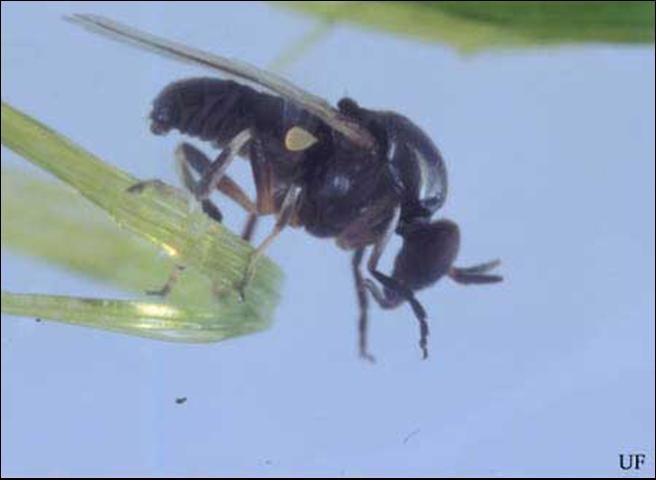
Credit: Lyle Buss, UF/IFAS
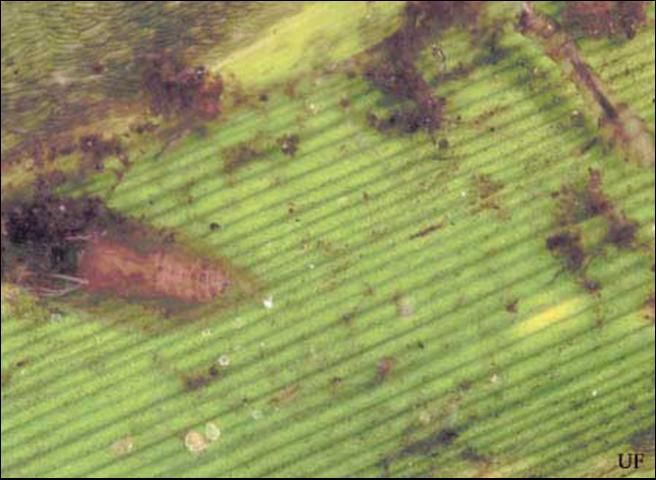
Credit: Jerry Butler, UF/IFAS
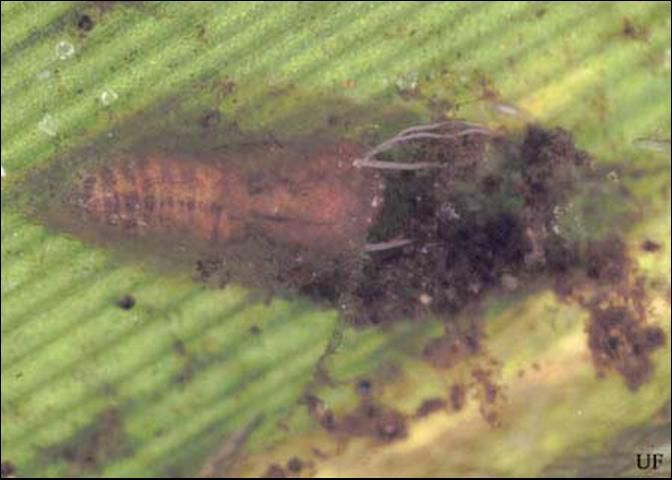
Credit: Jerry F. Butler, UF/IFAS
Population size of S. slossonae seems to be limited more by competition with other black fly species and cessation of water flow than from increases in water temperature. However with many black fly species, high populations are regulated more by suitable water for the developing larvae than anything else. The high water levels in 1998 have produced the large numbers of flies seen. The reduction of pollution levels generally seen in rivers across the nation has also led to an increase in suitable water for more black fly production because they prefer nonpolluted water (Figure 4). With the high numbers seen this spring, we feel that the predominant species may be able to produce their first egg batch without first taking a blood meal (autogeny), a common practice seen for other blood feeding insects.
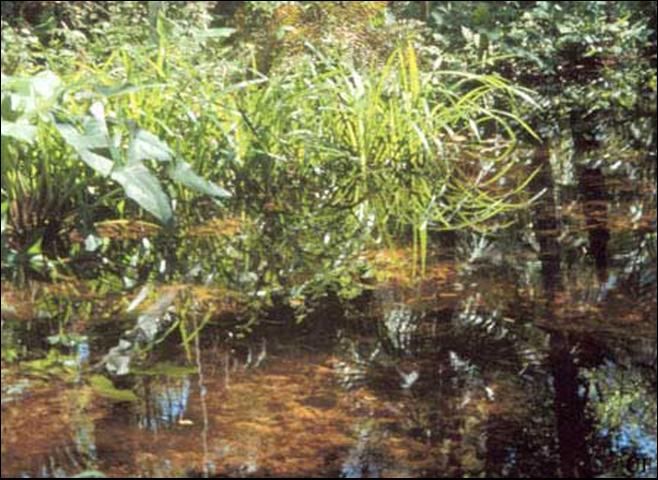
Credit: Jerry F. Butler, UF/IFAS
S. slossonae adults may fly four to eight miles from breeding sites in search of hosts, then return after feeding to breed and lay eggs. In parts of Africa, adult female black flies may travel more than forty miles from aquatic breeding sites to find blood meals. So, the biting problem at a particular location may be generated at some distance away, even in Florida.
Damage
Black flies have preferences for a wide range of individual host species. Adult females feed on the blood of humans, cattle, horses, sheep, goats, poultry, other livestock and wild mammals and birds. Each black fly species may prefer one type of host over another. The black fly common name sometimes indicates host specificity, for example the turkey gnat. Black flies are daytime biters preferring low wind conditions. They are not restricted to shaded or humid sites, and usually do not go indoors. They are attracted to hosts from a distance by smell, heat, and by sight. The female flies swarm around and crawl on the host preferring the head, hair, and ears as well as any skin that is exposed or that they can crawl onto. S. slossonae is primarily a bird feeder and probably preys on wild turkeys to some extent. It is the primary vector of the protozoan blood parasite, Leucocytozoon smithi, in Florida. This parasite is restricted only to birds, especially turkeys. S. slossonae will feed on domestic turkeys as well as chickens and other poultry. Several cases of chicken mortality attributed to black fly feeding were reported in Florida during the first three months of 1998.
Female black flies are blood feeders whose bites can itch and persist for several days. The flies bite by cutting into the skin and feeding on the pool of blood that forms in the hole they make (Figure 5). Anticoagulants injected into the feeding site by black flies can cause mild to severe allergic reactions in sensitive individuals. Strong reactions include fever, nausea and allergic dermatitis. Large black fly populations and strong bite reactions can be life threatening and have been reported to kill domestic animals. Black fly bites are very painful because of the hole that is cut in the skin, the anticoagulants and other materials that are injected, and the immunological differences between insect and hosts' tissues.
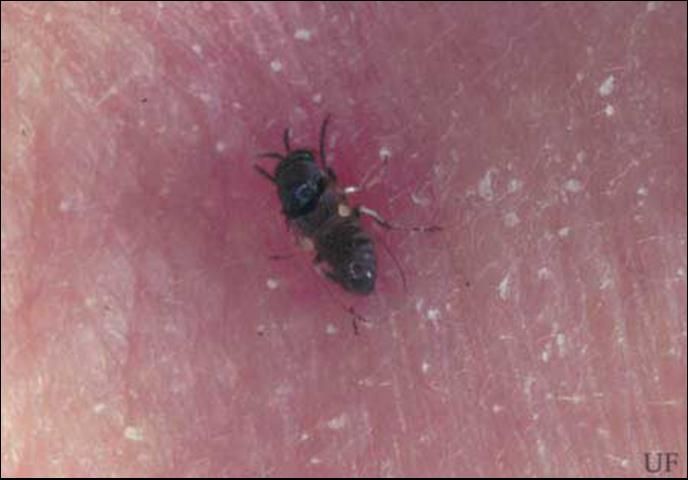
Credit: Jerry F. Butler, UF/IFAS
Some people are very attractive to black flies and have strong feeding reactions. Others appear to repel black flies and are bitten little if at all. Although S. slossonae is primarily a bird feeder, large swarms are attracted to people. Fortunately in Florida, most of the black flies attracted to people do not bite. Anyone showing strong allergic reactions should consult a physician for immediate treatment. Treatments for bites include antipruritic lotions or creams (Goddard 1993).
Management
Control of black flies is difficult because of the number of potential breeding sites. However, satisfactory control has been attained in some states by treating streams with the natural product, Bacillus thuringiensis var. israeliensis (Bti). The breeding sites in streams as well as the potential migration from these sites by the adult female black fly limits the use of chemical pesticides to regulate populations. Breeding site treatments have been used in Africa, but generally have not proven effective. Treatment of breeding sites (streams, rivers, etc.) would involve techniques similar to those used by mosquito control districts for treatment of mosquito larvae in aquatic habitats. Fogging for black flies would have to be done during the day when these insects are actively feeding and when fogging is least effective. These techniques do not seem effective against black flies in the northeastern United States.
Black flies are small enough to pass through window screen or come indoors on or in the hair. They do, however, prefer to bite out of doors. Long sleeve shirts, long pants and fine screen netting over head help prevent feeding. Repellents containing "DEET" formulations are not very effective for prevention of black fly bites. Individuals wearing DEET may actually have more black flies attracted to them than individuals not wearing DEET. Our tests indicate that some protection is given by herbal-based treatments with an active ingredient of geraniol. Permethrin products designed specifically to repel ticks also work for black flies as a clothing treatment, but can only be applied to fabrics, such as hats and shirts, and not to skin. Because black flies feed only during the day, our best advice is to limit your exposure to black flies. If this is not possible, try the available repellents in the hope that one of them will be effective for you in protecting against the black flies' bite.
For more information see: Insect Management Guide for black flies (https://edis.ifas.ufl.edu/IG081).
Selected References
Goddard, Jerome. 1993. Physicians Guide to Arthropods of Medical Importance. CRC Press. Boca Raton. pp 124–5.
Fasulo, T. R., W. Kern, P. G. Koehler, and D. E. Short. 2005. Pests In and Around the Home. Version 2.0. University of Florida/IFAS. CD-ROM. SW 126.
Pinkovsky, D. D. 1976. The black flies of Florida and their involvement in the transmission of Leucocytozoon smithi to turkeys. Ph.D. Dissertation, Univ. Florida, Gainesville.
Pinkovsky, D. D. and J. F. Butler. 1978. Black flies of Florida I. Geographic and seasonal distribution. Fla. Entomol. 61257–267.
Stone, A. and E. L. Snoddy. 1969. The black flies of Alabama (Diptera: Simuliidae). Auburn Univ. Agric. Exper. Sta. Bull. 390.